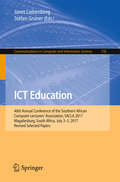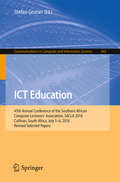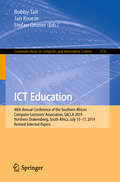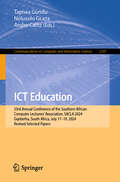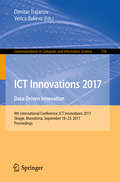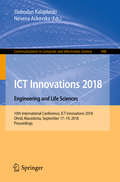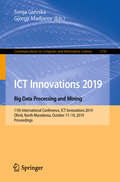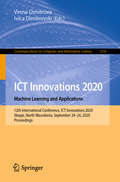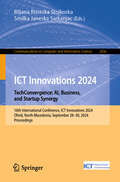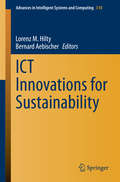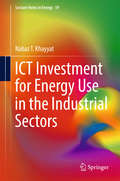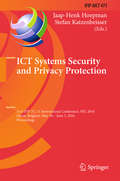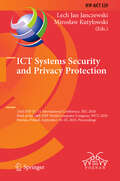- Table View
- List View
ICT Education
by Stefan Gruner Janet LiebenbergThis book constitutes the refereed proceedings of the 45th Annual Conference of the Southern African Computer Lecturers' Association on ICT Education, SACLA 2016, held in Cullinan, South Africa, in July 2016. The three revised full papers and 13 work-in-progress papers presented together with two invited keynote papers were carefully reviewed and selected from 30 submissions. The papers are organized in topical sections on assessment methods, instruction methods, new curricula, social skills, and various experiences.
ICT Education
by Stefan GrunerThis book constitutes the refereed proceedings of the 45th Annual Conference of the Southern African Computer Lecturers' Association on ICT Education, SACLA 2016, held in Cullinan, South Africa, in July 2016. The three revised full papers and 13 work-in-progress papers presented together with two invited keynote papers were carefully reviewed and selected from 30 submissions. The papers are organized in topical sections on assessment methods, instruction methods, new curricula, social skills, and various experiences.
ICT Education: 45th Annual Conference Of The Southern African Computer Lecturers' Association, Sacla 2016, Cullinan, South Africa, July 5-6, 2016, Revised Selected Papers (Communications in Computer and Information Science #642)
by Stefan Gruner Salah Kabanda Hussein Suleman45th Annual Conference Of The Southern African Computer Lecturers' Association, Sacla 2016, Cullinan, South Africa, July 5-6, 2016, Revised Selected Papers
ICT Education: 48th Annual Conference of the Southern African Computer Lecturers’ Association, SACLA 2019, Northern Drakensberg, South Africa, July 15–17, 2019, Revised Selected Papers (Communications in Computer and Information Science #1136)
by Stefan Gruner Bobby Tait Jan KroezeThis book constitutes the refereed proceedings of the 48th Annual Conference of the Southern African Computer Lecturers' Association on ICT Education, SACLA 2019, held in Northern Drakensberg, South Africa, in July 2019. The 16 revised full papers presented were carefully reviewed and selected from 57 submissions. The papers are organized in following topical sections: computer programming education; system security education; software engineering education; education of post-graduate research-students; our students, our profession.
ICT Education: 49th Annual Conference of the Southern African Computer Lecturers' Association, SACLA 2020, Virtual Event, July 6–9, 2020, Revised Selected Papers (Communications in Computer and Information Science #1518)
by Bobby Tait George Wells Monelo NxoziThis book constitutes the refereed proceedings of the 49th Annual Conference of the Southern African Computer Lecturers' Association on ICT Education, SACLA 2019, held in a virtual mode in South Africa, in July 2020. The 13 revised full papers presented were carefully reviewed and selected from 55 submissions. The papers focus on practical experiences in computing education, novel tools for learning and/or assessment, and research investigating aspects of computing education.
ICT Education: 50th Annual Conference of the Southern African Computer Lecturers' Association, SACLA 2021, Johannesburg, South Africa, July 16, 2021, Revised Selected Papers (Communications in Computer and Information Science #1461)
by Marijke Coetzee Wai Sze Leung Duncan Coulter Deon CotterrellThis book constitutes the refereed proceedings of the 50th Annual Conference of the Southern African Computer Lecturers' Association on ICT Education, SACLA 2021, held in Johannesburg, South Africa in July 2021. The 9 revised full papers presented were carefully reviewed and selected fromthe 23 submissions. One invited paper was also included in this volume. The papers are organized in following topical sections: past, present and future; teaching innovation; teaching methods and strategies.
ICT Education: 51st Annual Conference of the Southern African Computer Lecturers' Association, SACLA 2022, Cape Town, South Africa, July 21–22, 2022, Revised Selected Papers (Communications in Computer and Information Science #1664)
by Bruce W. Watson Richard J. Barnett Daniel B. le Roux Douglas A. ParryThis book constitutes the refereed proceedings of the 51st Annual Conference of the Southern African Computer Lecturers' Association, SACLA 2022, held in Cape Town, South Africa, during July 21–22, 2022.The 10 full papers were included in this book were carefully reviewed and selected from 31 submissions. They were organized in topical sections as follows: curriculum; assessment; teaching in context; innovative teaching; and pandemic pedagogy.
ICT Education: 52nd Annual Conference of the Southern African Computer Lecturers' Association, SACLA 2023, Gauteng, South Africa, July 19–21, 2023, Revised Selected Papers (Communications in Computer and Information Science #1862)
by Lynette Drevin Henri Emil Van Rensburg Dirk Petrus Snyman Günther Richard DrevinThis book constitutes the refereed proceedings of the 52nd Annual Conference of the Southern African Computer Lecturers' Association on ICT Education, SACLA 2023, held in Gauteng, South Africa, during July 19–21, 2023. The 12 full papers included in this book were carefully reviewed and selected from 42 submissions. They were organized in topical sections as follows: student centered teaching and learning; AI and future movements; programming; and beyond the classroom.
ICT Education: 53rd Annual Conference of the Southern African Computer Lecturers' Association, SACLA 2024, Gqeberha, South Africa, July 17–19, 2024, Revised Selected Papers (Communications in Computer and Information Science #2397)
by Tapiwa Gundu Noluxolo Gcaza Andre CalitzThis book constitutes the refereed proceedings of the 53rd Annual Conference of the Southern African Computer Lecturers' Association on ICT Education, SACLA 2024, held in Gqeberha, South Africa, during July 17–19, 2024. The 10 full papers included in this book were carefully reviewed and selected from 53 submissions. The SACLA 2024 conference served as a distinguished platform for exchanging original research and practical experiences, fostering dialogue on the teaching and learning of Information Systems, Computer Science, Information Technology and related disciplines.
ICT Equipment Investment and Growth in Low- and Lower-Middle-Income Countries
by Markus HaackerA report from the International Monetary Fund.
ICT Infrastructure and Computing: Proceedings of ICT4SD 2022 (Lecture Notes in Networks and Systems #520)
by Amit Joshi Shyam Akashe Milan TubaThis book proposes new technologies and discusses future solutions for ICT design infrastructures, as reflected in high-quality papers presented at the 7th International Conference on ICT for Sustainable Development (ICT4SD 2022), held in Goa, India, on 29–30 July 2022. The book covers the topics such as big data and data mining, data fusion, IoT programming toolkits and frameworks, green communication systems and network, use of ICT in smart cities, sensor networks and embedded system, network and information security, wireless and optical networks, security, trust, and privacy, routing and control protocols, cognitive radio and networks, and natural language processing. Bringing together experts from different countries, the book explores a range of central issues from an international perspective.
ICT Infrastructure and Computing: Proceedings of ICT4SD 2023, Volume 3 (Lecture Notes in Networks and Systems #754)
by Amit Joshi Shyam Akashe Milan TubaThis book proposes new technologies and discusses future solutions for ICT design infrastructures, as reflected in high-quality papers presented at the 8th International Conference on ICT for Sustainable Development (ICT4SD 2023), held in Goa, India, on August 3–4, 2023. The book covers the topics such as big data and data mining, data fusion, IoT programming toolkits and frameworks, green communication systems and network, use of ICT in smart cities, sensor networks and embedded system, network and information security, wireless and optical networks, security, trust, and privacy, routing and control protocols, cognitive radio and networks, and natural language processing. Bringing together experts from different countries, the book explores a range of central issues from an international perspective.
ICT Innovations 2017: Data-Driven Innovation. 9th International Conference, ICT Innovations 2017, Skopje, Macedonia, September 18-23, 2017, Proceedings (Communications in Computer and Information Science #778)
by Dimitar Trajanov and Verica BakevaThis book constitutes the refereed proceedings of the 9th International Conference on Data-Driven Innovation, ICT Innovations 2017, held in Skopje, Macedonia, in September 2017. The 26 full papers presented were carefully reviewed and selected from 90 submissions. They cover the following topics: big data analytics, cloud computing, data mining, digital signal processing, e-health, embedded systems, emerging mobile technologies, multimedia, Internet of Things (IoT), machine learning, software engineering, security and cryptography, coding theory, wearable technologies, wireless communication, and sensor networks.
ICT Innovations 2018. Engineering and Life Sciences: 10th International Conference, ICT Innovations 2018, Ohrid, Macedonia, September 17–19, 2018, Proceedings (Communications in Computer and Information Science #940)
by Slobodan Kalajdziski Nevena AckovskaThis book constitutes the refereed proceedings of the 10th International ICT Innovations Conference, ICT Innovations 2018, held in Ohrid, Macedonia, in September 2018.The 21 full papers presented were carefully reviewed and selected from 81 submissions. They cover the following topics:sensor applications and deployments, embedded and cyber-physical systems, robotics, network architectures, cloud computing, software infrastructure, software creation and management, models of computation, computational complexity and cryptography, design and analysis of algorithms, mathematical optimization, probability and statistics, data management systems, data mining, human computer interaction (HCI), artificial intelligence, machine learning, life and medical sciences, health care information systems, bioinformatics.
ICT Innovations 2019. Big Data Processing and Mining: 11th International Conference, ICT Innovations 2019, Ohrid, North Macedonia, October 17–19, 2019, Proceedings (Communications in Computer and Information Science #1110)
by Sonja Gievska Gjorgji MadjarovThis book constitutes the refereed proceedings of the 11th International ICT Innovations Conference, ICT Innovations 2019, held in Ohrid, Macedonia, in October 2019.The 18 full papers presented were carefully reviewed and selected from 75 submissions. They cover the following topics: sensor applications and deployments, embedded and cyber-physical systems, robotics, network architectures, cloud computing, software infrastructure, software creation and management, models of computation, computational complexity and cryptography, design and analysis of algorithms, mathematical optimization, probability and statistics, data management systems, data mining, human computer interaction (HCI), artificial intelligence, machine learning, life and medical sciences, health care information systems, bioinformatics.
ICT Innovations 2020. Machine Learning and Applications: 12th International Conference, ICT Innovations 2020, Skopje, North Macedonia, September 24–26, 2020, Proceedings (Communications in Computer and Information Science #1316)
by Vesna Dimitrova Ivica DimitrovskiThis book constitutes the refereed proceedings of the 12th International ICT Innovations Conference, ICT Innovations 2020, held in Skopje, North Macedonia, in September 2020.The 12 full papers and 6 short papers presented were carefully reviewed and selected from 60 submissions. The focal point of the volume is machine learning and applications in spheres of business, science and technology.
ICT Innovations 2021. Digital Transformation: 13th International Conference, ICT Innovations 2021, Virtual Event, September 27–28, 2021, Revised Selected Papers (Communications in Computer and Information Science #1521)
by Ljupcho Antovski Goce ArmenskiThis book constitutes the refereed proceedings of the 13th International ICT Innovations Conference, ICT Innovations 2021, held as virtual event in September 2021.The 15 full papers presented were carefully reviewed and selected from 58 submissions. The papers are organized in topical sections on deep learning and AI; NLP and social network analysis; theoretical foundations and information security; e-services; sensor systems, IoT.
ICT Innovations 2022. Reshaping the Future Towards a New Normal: 14th International Conference, ICT Innovations 2022, Skopje, Macedonia, September 29 – October 1, 2022, Proceedings (Communications in Computer and Information Science #1740)
by Katerina Zdravkova Lasko BasnarkovThis book constitutes the refereed proceedings of the 14th International Conference on ICT Innovations 2022. Reshaping the Future Towards a New Normal, ICT Innovations 2022, held in Skopje, Macedonia, during September 29–October 1, 2022. The 14 full papers and 1 short papers included in this book were carefully reviewed and selected from 42 submissions. They were organized in topical sections as follows: theoretical foundations and distributed computing; artificial intelligence and deep learning; applied artificial intelligence; education; and medical informatics.
ICT Innovations 2023. Learning: 15th International Conference, ICT Innovations 2023, Ohrid, North Macedonia, September 24–26, 2023, Proceedings (Communications in Computer and Information Science #1991)
by Marija Mihova Mile JovanovThis book constitutes the refereed proceedings of the 15th International Conference on ICT Innovations 2023. Learning: Humans, Theory, Machines, and Data, ICT Innovations 2023, held in Ohrid, North Macedonia during September 24–26, 2023.The 17 full papers included in this book were carefully reviewed and selected from 52 submissions. They are organized in sections by topics as follows: AI and natural language processing; bioinformatics; dew computing; e-learning and e-services; image processing; network science; theoretical informatics.
ICT Innovations 2024. TechConvergence: 16th International Conference, ICT Innovations 2024, Ohrid, North Macedonia, September 28–30, 2024, Proceedings (Communications in Computer and Information Science #2436)
by Biljana Risteska Stojkoska Smilka Janeska SarkanjacThis CCIS post conference volume constitutes the proceedings of the 16th International Conference on ICT Innovations, ICT Innovations 2024, held in Ohrid, North Macedonia, in September 2024. The 21 full papers included in this book were carefully reviewed and selected from 61 submissions. The papers covered a wide range of topics, including machine learning, network science, digital transformation, natural language processing.
ICT Innovations for Sustainability
by Lorenz M. Hilty Bernard AebischerICT Innovations for Sustainability is an investigation of how information and communication technology can contribute to sustainable development. It presents clear definitions of sustainability, suggesting conceptual frameworks for the positive and negative effects of ICT on sustainable development. It reviews methods of assessing the direct and indirect impact of ICT systems on energy and materials demand, and examines the results of such assessments. In addition, it investigates ICT-based approaches to supporting sustainable patterns of production and consumption, analyzing them at various levels of abstraction - from end-user devices, Internet infrastructure, user behavior, and social practices to macro-economic indicators. Combining approaches from Computer Science, Information Systems, Human-Computer Interaction, Economics, and Environmental Sciences, the book presents a new, holistic perspective on ICT for Sustainability (ICT4S). It is an indispensable resource for anyone working in the area of ICT for Energy Efficiency, Life Cycle Assessment of ICT, Green IT, Green Information Systems, Environmental Informatics, Energy Informatics, Sustainable HCI, or Computational Sustainability.
ICT Investment for Energy Use in the Industrial Sectors
by Nabaz T. KhayyatThis book investigates the impact of production input factors on the market, consumer and producer energy demand characteristics in 30 industrial sectors for South Korea over the period 1980-2009, and for Japan over the period 1973-2006, with special emphasis placed on the effects of ICT investment on the demand for energy. A dynamic factor demand model is developed, accounting for the adjustment costs that are defined in terms of forgone output from current production. It addresses four key aspects of production and energy demand in manufacturing: first, it establishes the various relationships between different factors of production. Second, it investigates whether the energy demand in the industrial sectors in South Korea would be decreased or increased by substituting/complementing with other input factors such as ICT capital and labor. Third, it looks at sources of growth in the industrial sectors through decomposing the Divisia index based total factor productivity (TFP). Finally it provides appropriate policy recommendations based on these findings. The results of this study may provide industrial sectors' stakeholders and environmental and industrial policy makers with a flexible model that has the capacity to assess outcomes of various policies under certain scenarios. The factor demand methodology described in this book is very advanced and up-to-date. It can be used when teaching advanced graduate courses and in empirically advanced research. Therefore, it is highly relevant in both teaching as a main or supplementary text and in particular as a reference handbook in conducting empirical research. The focus on ICT effects on energy use makes this book an important addition to the existing literature on industrial development.
ICT Strategies for Schools: A Guide for School Administrators
by Laxman Mohanty Neharika VohraRecognizing the potential of ICTs to make the classroom transaction of curriculum significantly more relevant and purposeful, principals and school administrators in India need to design appropriate IT strategies and oversee the entire implementation process in their schools. This book is guide to the use of ICT in schools, covering issues of pedagogy, curriculum and learning. In brief, it deals with - Education uses of IT - Criteria for selection of hardware and software - Designing an IT-assisted curriculum - Teacher recruitment, training and desired competencies - Management and financial issues - Possible problem areas: plagiarism, privacy, hacking Lucidly written, with case studies highlighting successful strategies, this volume will be of immense importance to principals and administrators of schools as also students of education.
ICT Systems Security and Privacy Protection
by Stefan Katzenbeisser Jaap-Henk HoepmanThis book constitutes the refereed proceedings of the 31st IFIP TC 11 International Conference on ICT Systems Security and Privacy Protection, SEC 2016, held in Ghent, Belgium, in May/June 2016. The 27 revised full papers presented were carefully reviewed and selected from 139 submissions. The papers are organized in topical sections on cryptographic protocols, human aspects of security, cyber infrastructure, social networks, software vulnerabilities, TPM and internet of things, sidechannel analysis, software security, and privacy.
ICT Systems Security and Privacy Protection: 33rd IFIP TC 11 International Conference, SEC 2018, Held at the 24th IFIP World Computer Congress, WCC 2018, Poznan, Poland, September 18-20, 2018, Proceedings (IFIP Advances in Information and Communication Technology #529)
by Lech Jan Janczewski Mirosław KutyłowskiThis book constitutes the refereed proceedings of the 33rd IFIP TC 11 International Conference on Information Security and Privacy Protection, SEC 2018, held at the 24th IFIP World Computer Congress, WCC 2018, in Poznan, Poland, in September 2018.The 27 revised full papers presented were carefully reviewed and selected from 89 submissions. The papers present novel research on theoretical and practical aspects of security and privacy protection in ICT systems. They are organized in the following topical sections: authentication, failures of security management, security management/forensic, and software security/attacks.
